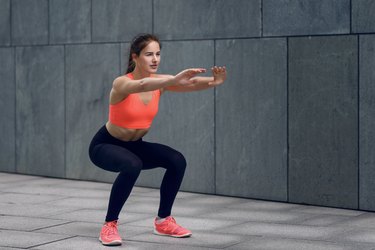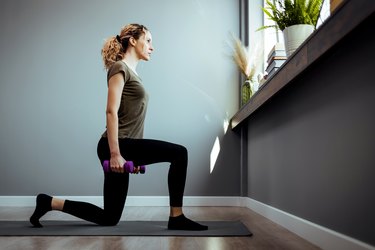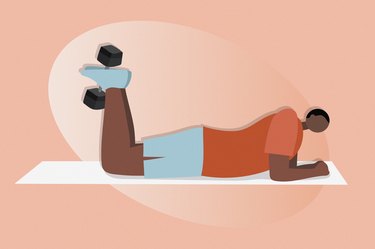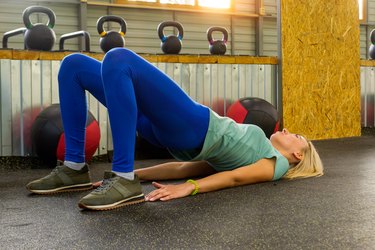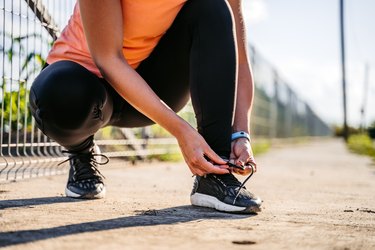
Walking has countless benefits for your physical and mental health. But does walking help you build muscle?
In a widely cited October 2010 review, the Journal of Strength and Conditioning Research explains that muscle building, also known as hypertrophy, occurs through three key mechanisms:
Video of the Day
Video of the Day
- Mechanical tension: how much load and tension is placed on your muscles during exercise. It's especially important to take muscles through their full range of motion under load.
- Muscle damage: small tears to the muscle and other types of damage that occur during exercise
- Metabolic stress: the buildup of metabolites and other changes that occur inside muscles which turn on muscle-building pathways
In other words, exercise has to be intense enough to disrupt our internal state in a noticeable way. Without this, our bodies have no incentive to build bigger muscles.
People who are currently deconditioned, meaning they've lost fitness from lack of exercise, may find that beginning a walking routine leads to some muscle growth in their legs.
An April 2014 review published in Exercise and Sports Sciences Reviews found that aerobic exercise such as walking, running and cycling has been shown to lead to muscle hypertrophy in older adults and sedentary people.
For the vast majority of people, however, walking is simply not intense enough to stimulate muscle growth, according to Bryan Krahn, CSCS. There's not enough load, not enough range of motion and not enough internal disruption to elicit hypertrophy.
If you're hoping to get stronger through walking, you don't need bigger muscles to do that. But you do need challenging loads to gain strength. This means you must practice any movement you want to strengthen and make it harder over time.
Walking may help you build strength to a point (especially if your body is unaccustomed to it), but for most people it is simply not intense or specific enough to drive serious strength gains.
Tip
Walking is an excellent form of aerobic exercise and has many benefits, but building muscle isn't likely to be one of them. If you want to increase muscle mass in your legs, resistance training is key.
The Best Way to Build Muscle in Your Legs
If you want to build muscle, Krahn says you need to engage in some type of resistance training. Resistance training places significantly higher loads on your muscles than walking and can lead to serious muscle growth over time when paired with the right amount of food and recovery.
"Everyone starts somewhere, and for some that might mean doing supported bodyweight squats or lunges," Krahn says. He suggests that you focus first on doing more reps, then add resistance or progress to more complex exercises over time.
Exercises like squats, deadlifts, lunges, leg curls and bridges will do a lot more to help you build muscle than walking alone. As a bonus, those exercises will help you build and strengthen the muscles used in walking so you can walk with faster, longer and easier.
Start Here to Build Leg Muscle
Does Walking Tone Your Legs?
When most people talk about muscle toning, they're referring to looking leaner and having more visible defined muscles. This requires a combination of building muscle and also losing body fat.
Walking can certainly help with fat loss: It's a great way to increase your normal heart rate and burn more calories throughout the day. Calories burned through leisure walking are a part of NEAT (non exercise activity thermogenesis), which includes all forms of daily movement other than intentional exercise.
NEAT has a huge impact on fat loss because it can make up a large percentage of the calories we burn each day. According to the National Institutes of Health, NEAT is responsible for 6 to 10 percent of total energy expenditure in people who are mainly sedentary. If you're highly active, it could make up 50 percent or more of your total calorie burn. This means that walking more can substantially increase your metabolism and make it easier to lose fat.
It's also the ideal form of easy exercise to complement your strength training sessions. "Going for walks is a great option if you want to lose fat because it won't place extra demands on your body beyond your lifting workouts," Krahn says. "Too much intense cardiovascular training can affect recovery."
Every time you engage in moderate or intense exercise, your body needs time to repair itself. This recovery process can include repairing damage to muscles, replenishing fuel stores and restoring hormonal balance.
More intense exercise (including lifting weights or doing cardio) requires more behind-the-scenes work for our bodies to build back better for next time. During the recovery process, you're going to be more fatigued and continuing to train hard can be counterproductive.
Walking doesn't require the same recovery tax as other types of exercise because it is such a low intensity; walking can actually aid in the recovery process from more intense training by helping promote blood flow to recovering tissues. This makes easy walking a great choice for active recovery days when you're resting between other hard workouts.
By focusing on building muscle in the weight room, paying attention to your nutrition and using walking as active recovery, you can build a leaner, more toned body.
Tip
Combine walking with another form of exercise, such as running or strength training. Alternating running days with walking days, for example, can aid recovery by increasing circulation in your legs while giving your joints a rest.
Ways to Make Walking More Intense
Add Hills
You can walk up and down hills — or crank up the incline on your treadmill. Some people also like to go for rucks, which means walking with a weighted backpack or vest. Lots of hiking, rucking or backpacking with a steep vertical gain will likely lead to some hypertrophy in your calves, glutes and quads.
Add Weight
Wearing a weighted vest or heavy backpack can help make your walks more intense. It's important not to go overboard here as too much load can contribute to wear and tear on your joints. Start with as little as 10-15 lbs of weight and work your way up to 20-30% of your bodyweight. It's not recommended to regularly ruck with more than 30% of your bodyweight.
Add Speed
Walking faster, either outdoors, on a track or on a treadmill, is an easy way to up the intensity. This will increase the cardiovascular load, but it won't help muscle building. (Feeling unsteady on your walks? Check out our recs for the best walking shoes with ankle support.)
Bumping up the intensity in any of these ways pushes walking from more of an easy recovery activity into the zone of cardio training. You will burn more calories and could potentially see a bit more muscle growth, especially if you're walking up and down hills with a heavy pack.
The tradeoff is that more intense walking requires more recovery. Whereas you can easily go for leisure walks several times a day, you need to consider the rest of your training week if you're going to plug in rucks, hills or brisk walking. These types of intense walking take a greater toll on your body.
Use Walks to Complement Other Training
Before you try to make your walks as hard as possible, consider that you may actually be missing out on some of the biggest benefits of walking.
Krahn believes it's important that walking is less intense and demanding than other forms of exercise. "There should be a difference between the intensity of walking and cardiovascular training," he says. "The biggest benefits of walking are not fitness related."
These benefits include things like stress reduction and other mental health improvements, spending time outside in the sunshine and connecting with nature or loved ones.
Intentionally going hard, heavy or fast with your walks has its place, but it can reduce the impact of some of these other benefits.
So, if you want to build more muscular or toned legs, make sure you're doing some resistance training and matching your nutrition with your goals, such as upping your protein intake. Then, consider building a practice around regular leisure walking to benefit your overall wellbeing. There are some great walking apps that can make adding in walking easy and fun.
"Walking is pure life extension," Krahn says. "It's the most fundamental thing we do."
Was this article helpful?
150 Characters Max
0/150
Thank you for sharing!
Thank you for your feedback!
